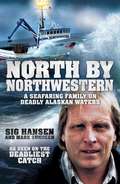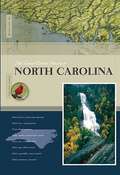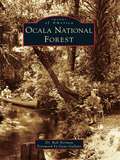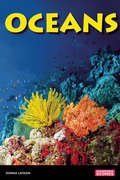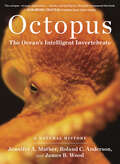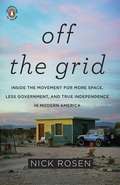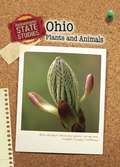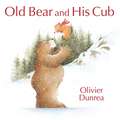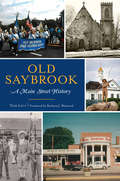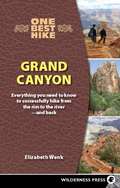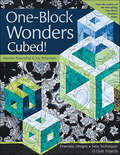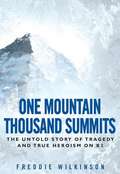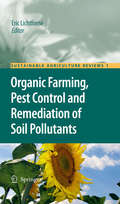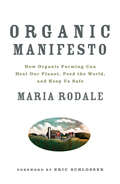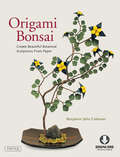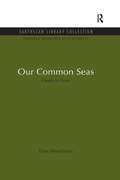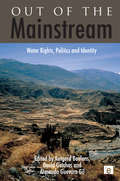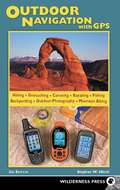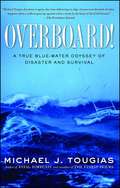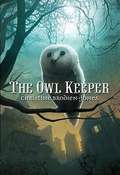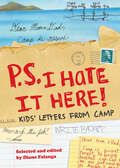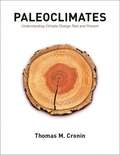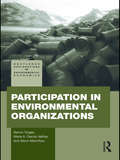- Table View
- List View
North by Northwestern: A Seafaring Family on Deadly Alaskan Waters
by Sig Hansen Mark SundeenSig Hansen has been a star of the Channel 4's The Deadliest Catch from the pilot to the present. Seen in over 150 countries, the show attracts more than 49 million viewers per season, making it one of the most successful series in the history of cable TV. With its daredevil camera work, unpredictably dangerous weather, and a setting as unforgivable and unforgettable as the frigid Bering Sea, The Deadliest Catch is unlike anything else on television. But the weatherworn fishermen of the fishing vessel Northwestern have stories that don't come through on TV. For Sig Hansen and his brothers, commercial fishing is as much a part of their Norwegian heritage as their names. Descendents of the Vikings who roamed and ruled the northern seas for centuries, the Hansens' connection to the sea stretches from Alaska to Seattle and all the way to Norway. And after twenty years as a skipper on the commercial fishing vessel the Northwestern -- which was his father's before him -- Sig has lived to tell the tales. To be a successful fisherman, you need to be a mechanic, navigator, welder, painter, carpenter, and sometimes, a firefighter. To be a successful fisherman year after year, you need to be a survivor. This is the story of a family of survivors; part memoir and part adventure tale, North by Northwestern brings readers on deck, into the dockside bars and into the history of a family with a common destiny. Built around a gripping tale of a deadly shipwreck like The Perfect Storm, North by Northwestern is the multi-generational tale of the Hansen family, a clan of tough Norwegian-American fishermen who, through the popularity of The Deadliest Catch, have become modern folk-heroes.
North Carolina
by Teresa WimmerIntroduction to the state of North Carolina, including its early history, its land and resources, some of its famous people, and unique events.
Ocala National Forest (Images of America)
by Dr Rob Norman Gene GallantThe Ocala National Forest, founded on November 24, 1908, by Pres. Theodore Roosevelt, is the oldest national forest in the eastern continental United States. The forest is one of Central Florida's last remaining expanses of forested lands with magnificent palms, towering live oaks, and the largest sand pine scrub population in the world. The Ocala National Forest contains major springs, including Salt Springs, Silver Glen, Alexander, and Juniper Run. In addition to several wilderness areas for visitors seeking primitive conditions and solitude, the forest has visitor centers, nature trails, and a section of the Florida Trail. Images of America: Ocala National Forest is filled with fascinating stories and exciting facts on the history of the steamboats, logging, trails, movie sets (including The Yearling, based on the Pulitzer Prize-winning novel by Marjorie Kinnan Rawlings), Cracker cowboys, modern conservation efforts, and more.
Oceans
by Donna LathamInvestigating the planet's biomes and examining the modern threats to each ecosystem, this interactive series challenges young readers to look at how their own actions affect the planet's health. With compare-and-contrast facts and vocabulary-building sidebars, each engaging guide reveals how environmental threats-both human and natural-affect plants and animals.Detailing the largest biome, this guide surveys the environmental threats to the earth's oceans. Teaching students about coral reefs-the rainforests of the ocean-this educational resource explores topics such as the connection between increasing levels of carbon dioxide in the atmosphere and the bleaching of the reefs. By comparing the size of an island of floating plastic and other trash in the middle of the Pacific Ocean to the state of Texas-and how that floating island impacts ocean life-the guide shows young environmentalists why consuming less plastic is important.
Octopus: The Ocean's Intelligent Invertebrate
by James B. Wood Roland C. Anderson Jennifer A. MatherThe visually arresting and often misunderstood octopus has long captured popular imagination. With an alien appearance and an uncanny intellect, this exceptional sea creature has inspired fear in famous lore and legends—from the giant octopus attack in 20,000 Leagues Under the Sea to Ursula the sea witch in The Little Mermaid. Yet its true nature is more wondrous still. After decades of research, the authors reveal a sensitive, curious, and playful animal with remarkable intelligence, an ability to defend itself with camouflage and jet propulsion, an intricate nervous system, and advanced problem-solving abilities. In this beautifully photographed book, three leading marine biologists bring readers face to face with these amazingly complex animals that have fascinated scientists for decades. From the molluscan ancestry of today’s octopus to its ingenious anatomy, amazing mating and predatory behaviors, and other-worldly relatives, the authors take readers through the astounding life cycle, uncovering the details of distinctive octopus personalities. With personal narratives, underwater research, stunning closeup photography, and thoughtful guidance for keeping octopuses in captivity, Octopus is the first comprehensive natural history of this smart denizen of the sea.
Off the Grid
by Nick RosenInside the subculture of off-grid living Written by a leading authority on living off the grid, this is a fascinating and timely look at one of the fastest growing movements in America. In researching the stories that would become Off the Grid, Nick Rosen traveled from one end of the United States to the other, spending time with all kinds of individuals and families striving to live their lives the way they want to-free from dependence on municipal power and amenities, and free from the inherent dependence on the government and its far-reaching arms. While the people profiled may not have a lot in common in terms of their daily lives or their personal background, what they do share is an understanding of how unique their lives are, and how much effort and determination is required to maintain the lifestyle in the face of modern America's push toward connectivity and development. .
Ohio Plants and Animals (Heinemann State Studies)
by Marcia SchonbergWhere is Ohio can you find 300-year-old oak trees? Which pesticide has endangered the bald eagle in Ohio? What kinds of animals live in Ohio's cities? This books contains all kinds of fun and fascinating facts about the plants and animals of Ohio and the habitats in which they live. You'll find information about where and how Ohio plants and animals live, and how these living things fit into the ecosystem. Plus, you'll find out what actions are being taken to protect Ohio's natural environment.
Old Bear and His Cub (Little Cub)
by Olivier DunreaFrom the creator of the Gossie and Gertie books comes a playful and charming twist on the relationship between children and the adults who care for them.Old Bear loves Little Cub with all his heart. He makes sure that Little Cub eats all his porridge, takes a nap during their snowy walk, and wraps his red scarf tightly around his ears. Little Cub doesn't want to be told what to do, but he always listens to Old Bear because he knows that Old Bear loves him so. But when Old Bear catches a cold, it's Little Cub who knows just what to do to make Old Bear feel better. This winning story shows just how much Old Bears and Little Cubs love one another--with all their hearts.
Old Saybrook: A Main Street History (Brief History)
by Tedd LevyHere in this distinctive New England town, Main Street is the place to meet your neighbors, get a coffee, do your shopping, watch a parade, attend a concert, worship, vote or volunteer. And behind the familiar buildings is a colorful history. There's the humorist who organized his neighbors to buy land and build a town hall that later became the Katharine Hepburn Cultural Arts Center. The story of how the Monkey Farm got its name. The nighttime parade that draws thousands. And the heartwarming account of the shopkeeper who sent penny candy to students with good grades. Author Tedd Levy reveals the unique buildings, events, people and heritage of this distinctive thoroughfare.
On Zion’s Mount: Mormons, Indians, and the American Landscape
by Jared FarmerShrouded in the lore of legendary Indians, Mt. Timpanogos beckons the urban populace of Utah. And yet, no “Indian” legend graced the mount until Mormon settlers conjured it—once they had displaced the local Indians, the Utes, from their actual landmark, Utah Lake. On Zion’s Mount tells the story of this curious shift. It is a quintessentially American story about the fraught process of making oneself “native” in a strange land. But it is also a complex tale of how cultures confer meaning on the environment—how they create homelands. Only in Utah did Euro-American settlers conceive of having a homeland in the Native American sense—an endemic spiritual geography. They called it “Zion.” Mormonism, a religion indigenous to the United States, originally embraced Indians as “Lamanites,” or spiritual kin. On Zion’s Mount shows how, paradoxically, the Mormons created their homeland at the expense of the local Indians—and how they expressed their sense of belonging by investing Timpanogos with “Indian” meaning. This same pattern was repeated across the United States. Jared Farmer reveals how settlers and their descendants (the new natives) bestowed “Indian” place names and recited pseudo-Indian legends about those places—cultural acts that still affect the way we think about American Indians and American landscapes.
One Best Hike: Grand Canyon
by Elizabeth WenkOne of the world's most spectacular places, the Grand Canyon annually attracts over 4 million visitors who peer over the edge of the abyss. A smaller number of them trek from the rim to the banks of the Colorado River on one of the nation's best-known hikes. Many of these hikers are inadequately prepared for the rigors of what can be a deadly journey. This indispensable guide describes the most popular route into the canyon - the 16.2 mile round-trip route from the South Rim to the Colorado River. It addresses the many possible hazards (extreme heat, cold, elevation gain/loss of over 9,000 feet), gives advice on physical conditioning, and includes helpful charts, maps, and GPS waypoints for the best rest points. The hike itself is covered mile by mile, with expert coaching and hints along the way. Experienced and novice hikers alike will benefit from its encouraging, can-do approach.
One-Block Wonders Cubed!: Dramatic Designs, New Techniques, 10 Quilt Projects
by Maxine Rosenthal Joy PelzmannAdd New Dimension to Your Favorite Hexagon Quilts • Your favorite One-Block Wonders authors are back with new graphic techniques using triangles, cubes, and appliqué • Learn how to create optical illusions with your fabrics • Bonus projects include totes, coasters and placemats for using up left-over hexagons • Create interesting shadow effects with clever fabric placement • Try new kinds of borders with uneven edges, creative shapes, and hexagon strips From the best-selling authors of the One-Block Wonders books. New techniques and design strategies using simple geometric shapes give you dramatic quilt imagery that seems to defy logic! Take the ordinary and turn it into something extraordinary with this book.
One Mountain Thousand Summits: The Untold Story of Tragedy and True Heroism on K2
by Freddie WilkinsonAn insider's account of one of the deadliest and most controversial tragedies in mountaineering history-the 2008 K2 disaster. When eleven men perished on the slopes of K2 in August 2008, it was one of the deadliest single events in Himalayan climbing and made headlines around the world. Yet non of the surviving western climbers could explain precisely what happened. Their memories were self-admittedly fogged by exhaustion, hypoxia, and hallucinations. The truth of what happened lies with four Sherpa guides who were largely ignored by the mainstream media in the aftermath of the tragedy, who lost two of their own during the incident, and whose heroic efforts saved the lives of at least four climbers. Based on his numerous trips to Nepal and in-depth interviews he conducted with these unacknowledged heroes, the other survivors, and the families of the lost climbers, alpinist and veteran climbing writer Freddie Wilkinson presents the true story of what actually occurred on the "savage" mountain. This work combines a criticism of the mainstream press's less-than-complete coverage of the tragedy and an insightful portrait of the lives of 21st-century Sherpas into an intelligent, white-knuckled adventure narrative. .
Organic Farming, Pest Control and Remediation of Soil Pollutants
by Eric LichtfouseSustainable agriculture is a rapidly growing field aiming at producing food and energy in a sustainable way for humans and their children. Sustainable agriculture is a discipline that addresses current issues such as climate change, increasing food and fuel prices, poor-nation starvation, rich-nation obesity, water pollution, soil erosion, fertility loss, pest control, and biodiversity depletion. Novel, environmentally-friendly solutions are proposed based on integrated knowledge from sciences as diverse as agronomy, soil science, molecular biology, chemistry, toxicology, ecology, economy, and social sciences. Indeed, sustainable agriculture decipher mechanisms of processes that occur from the molecular level to the farming system to the global level at time scales ranging from seconds to centuries. For that, scientists use the system approach that involves studying components and interactions of a whole system to address scientific, economic and social issues. In that respect, sustainable agriculture is not a classical, narrow science. Instead of solving problems using the classical painkiller approach that treats only negative impacts, sustainable agriculture treats problem sources. Because most actual society issues are now intertwined, global, and fast-developing, sustainable agriculture will bring solutions to build a safer world. This book series gathers review articles that analyze current agricultural issues and knowledge, then propose alternative solutions. It will therefore help all scientists, decision-makers, professors, farmers and politicians who wish to build a safe agriculture, energy and food system for future generations.
Organic Manifesto: How Organic Food Can Heal Our Planet, Feed the World, and Keep Us Safe
by Maria RodaleRodale was founded on the belief that organic gardening is the key to better health both for us and for the planet, and never has this message been more urgent. Now, with Organic Manifesto, Maria Rodale, chairman of Rodale, sheds new light on the state of 21st century farming. She examines the unholy alliances that have formed between the chemical companies that produce fertilizer and genetically altered seeds, the agricultural educational system that is virtually subsidized by those same companies, and the government agencies in thrall to powerful lobbyists, all of which perpetuate dangerous farming practices and deliberate misconceptions about organic farming and foods. Interviews with government officials, doctors, scientists, and farmers from coast to coast bolster her position that chemical-free farming may be the single most effective tool we have to protect our environment and, even more important, our health.
Origami Bonsai
by Benjamin John ColemanMake beautiful origami flowers then arrange them into stunning bonsai sculptures with this wonderful origami book. By merging two iconic Japanese art forms—origami and bonsai—Benjamin Coleman sparked an exciting evolution in paper folding, and made a name for himself in both the origami world and on the Etsy landscape. In addition to sharing his revolutionary paper crafting techniques, Coleman also shows you how to select natural twigs, branches, and stones—and how to assemble them into a lifelike finished origami sculpture. To help in the creation process the book contains detailed instructions and numerous photographs of both works in process and completed origami bonsai pieces that are sure to have you crating your own decorative origami art in no time. This easy origami book contains: Beautiful, multi-color photos and drawings Step-by-step instructions Explanations of dozens of folding techniques 3 hours of downloadable video Folding paper flowers is a great way for beginners to learn origami while still making an impressive finished bonsai sculpture. Even experienced folders will find new and original designs to add to their origami repertoires! Origami flower projects include: The Ficus Leaf The Berlin Poplar Leaf The Black Eyed Susan The Foxglove The Buttercup And many more. . .
Origami Bonsai
by Benjamin John ColemanOrigami bonsai is the art of folding paper flowers and leaves which are glued to natural branches, creating exquisite botanical sculptures. Origami Bonsai teaches readers from all walks of life the skills necessary to create these intricate and stunning pieces of art.The beauty of origami bonsai is that even newcomers to paperfolding can create fantastic arrangements. With each page of the book readers will have the opportunity to create their own amazingly lifelike sculptures. Revolutionary approaches in this book include mass production of leaves, painting techniques and depth enhancement. Each page leads to new discoveries that will inspire the creation of wildly complex plant sculptures. Readers will be surprised at how easy these sculptures are to create, and how much they are appreciated by others.
Our Common Seas: Coasts in Crisis (Natural Resource Management Set)
by Don HinrichsenMost of the world's population lives on or near the coasts. Every nation not completely landlocked has used the sea as its supposedly self-cleansing garbage dump. Now the effects are being felt. There is not a coast in the world which is not dangerously polluted. Sewage, oil, plastics, industrial effluents, radioactive waste have been added to ungoverned development, all of which are busily destroying otherwise robust inshore eco-systems. Hinrichsen, basing his work on United Nations Environment Programme (UNEP) research and his own extensive travels, has described the situation in the Mediterranean, the Gulf, the Indian Ocean, the South-East Asian Seas and the Eastern Pacific. He covers both the disasters and the growing successes in dealing with them, and he points the way to the sort of international deal needed to rescue a vast resource in danger of complete destruction. His book is both a call to action and a sign of hope. Originally published in 1990
Out of the Mainstream: Water Rights, Politics and Identity
by Rutgerd Boelens David Getches Armando Guevara-GilWater is not only a source of life and culture. It is also a source of power, conflicting interests and identity battles. Rights to materially access, culturally organize and politically control water resources are poorly understood by mainstream scientific approaches and hardly addressed by current normative frameworks. These issues become even more challenging when law and policy-makers and dominant power groups try to grasp, contain and handle them in multicultural societies. The struggles over the uses, meanings and appropriation of water are especially well-illustrated in Andean communities and local water systems of Peru, Chile, Ecuador, and Bolivia, as well as in Native American communities in south-western USA. The problem is that throughout history, these nation-states have attempted to 'civilize' and bring into the mainstream the different cultures and peoples within their borders instead of understanding 'context' and harnessing the strengths and potentials of diversity. This book examines the multi-scale struggles for cultural justice and socio-economic re-distribution that arise as Latin American communities and user federations seek access to water resources and decision-making power regarding their control and management. It is set in the dynamic context of unequal, globalizing power relations, politics of scale and identity, environmental encroachment and the increasing presence of extractive industries that are creating additional pressures on local livelihoods. While much of the focus of the book is on the Andean Region, a number of comparative chapters are also included. These address issues such as water rights and defence strategies in neighbouring countries and those of Native American people in the southern USA, as well as state reform and multi-culturalism across Latin and Native America and the use of international standards in struggles for indigenous water rights. This book shows that, against all odds, people are actively contesting neoliberal globalization and water power plays. In doing so, they construct new, hybrid water rights systems, livelihoods, cultures and hydro-political networks, and dynamically challenge the mainstream powers and politics.
Outdoor Navigation with GPS
by Stephen W. HinchFor outdoor adventurers who hike, fish, kayak, cross-country ski, or mountain bike in the backcountry, a GPS receiver can help them reach their destination and return safely - but only if they know how to use it! Here is the guide to getting the most out of a GPS receiver, from basic consumer advice to advanced techniques. It even includes fun solo and team games that utilize GPS. Starting with essential definitions and moving on to creating waypoints, and using your GPS with a computer, this succinct book teaches the basics of navigation and outdoor GPS use. Advanced techniques are covered, such as creating custom maps, and new technologies are discussed, including using GPS-enabled mobile phones, and how to use GPS with Google Earth and Google Maps. With years of experience as a GPS instructor, Hinch is well-versed in all aspects of navigation and GPS use, and he covers them in a jargon-free, easy-to-follow style.
Overboard!
by Michael J. TougiasFrom masterful storyteller Michael J. Tougias comes a new, heart-stopping true-life tale of maritime disaster, his most thrilling and amazing story yet. In May 2005, Tom Tighe, captain of a forty-five-foot-long sailboat named the Almeisan, and his first mate, Loch Reidy, welcomed three new crewmembers for a five-day voyage from Connecticut across the blue waters of the Gulf Stream to sun-drenched Bermuda. The new crew included forty-six-year-old Kathy Gilchrist, seventy-year-old Ron Burd, and thirty-four-year-old Chris Ferrer. Although Tighe had made the trip forty-eight times, with Reidy accompanying him on twenty of those voyages, the rest of the crew had joined to learn more about offshore sailing. Four days into the voyage, an enormous storm struck, sweeping two of the crew into the towering sea. The remaining crewmembers managed to stay aboard the vessel as it was slowly torn apart by the rampaging ocean. Overboard! follows the simultaneous desperate struggles of both those still on the boat and those fighting for their lives in the sea. The Coast Guard, alerted to the Almeisan's distress, rushed to the storm-tossed scene. Their ensuing search and rescue mission proved so spectacularly difficult and dangerous that it was later selected--from among thousands of incidents--as the Guard's search and rescue case of the year. Highly trained helicopter pilots and rescue swimmers alike found themselves in almost as much trouble as those trapped by the ferocious ocean. By turns tragic, thrilling, and deeply inspiring, Overboard! is a riveting, fast-paced story of death and survival at sea--amazing, unforgettable, and all true.
The Owl Keeper
by Christine Brodien-Jones Maggie KneenMaxwell Unger has always loved the night. He used to do brave things like go tramping through the forest with his gran after dark. He loved the stories she told him about the world before the Destruction—about nature, and books, and the silver owls. His favorite story, though, was about the Owl Keeper. According to Max’s gran, in times of darkness the Owl Keeper would appear to unite owls and sages against the powers of the dark. Gran is gone now, and so are her stories of how the world used to be. Max is no longer brave. The forest is dangerous, the books Gran had saved have been destroyed, and the silver owls are extinct. At least that’s what the High Echelon says. But Max knows better. Maxwell Unger has a secret. And when a mysterious girl comes to town, he might just have to start being brave again. The time of the Owl Keeper, Gran would say, is coming soon. From the Hardcover edition.
P.S. I Hate It Here: Kids' Letters from Camp
by Diane FalangaHeartwarming and hilarious real-life letters from kids at summer camp sure to amuse anyone who’s ever been a homesick child or a parent of one.In the bestselling tradition of nostalgic looks at classic rites of passage, such as Camp Camp and Bar Mitzvah Disco, P.S. I Hate It Here: Kids’ Letters from Camp captures a childhood experience shared by millions. This collection of real letters written by children ages eight to sixteen to their parents about their adventures at summer camp are laugh-out-loud funny and will have readers reminiscing about their own camp days.More than 150 letters cover all the imaginable scenarios of sleep away camp, from acing the cabin lice inspection, to rowing in the “ricotta” race, to breaking the bad news about a retainer lost in the wilderness. These letters reveal that kids are wittier and more sophisticated than we might assume, and that the experience of being away from home for the first time creates hilarious and lasting memories.“Trust me when I tell you that not only will your kids get a kick out of the amazingly funny letters contained in this book, you and your friends will too.” —Chicago Parent Magazine“P.S. I Hate It Here”compiles notes home from camp with love—a handsome, actually quite beautiful, little book.” —Chicago Tribune“Whether your kid is in camp or you cherish your own memories of s'mores and Color Wars, you'll get a kick out of P.S. I Hate It Here!, a book of real-life, laugh-out-loud letters from camp.” —Redbook Magazine
Paleoclimates: Understanding Climate Change Past and Present
by Thomas CroninThe field of paleoclimatology relies on physical, chemical, and biological proxies of past climate changes that have been preserved in natural archives such as glacial ice, tree rings, sediments, corals, and speleothems. Paleoclimate archives obtained through field investigations, ocean sediment coring expeditions, ice sheet coring programs, and other projects allow scientists to reconstruct climate change over much of earth's history. When combined with computer model simulations, paleoclimatic reconstructions are used to test hypotheses about the causes of climatic change, such as greenhouse gases, solar variability, earth's orbital variations, and hydrological, oceanic, and tectonic processes. This book is a comprehensive, state-of-the art synthesis of paleoclimate research covering all geological timescales, emphasizing topics that shed light on modern trends in the earth's climate. Thomas M. Cronin discusses recent discoveries about past periods of global warmth, changes in atmospheric greenhouse gas concentrations, abrupt climate and sea-level change, natural temperature variability, and other topics directly relevant to controversies over the causes and impacts of climate change. This text is geared toward advanced undergraduate and graduate students and researchers in geology, geography, biology, glaciology, oceanography, atmospheric sciences, and climate modeling, fields that contribute to paleoclimatology. This volume can also serve as a reference for those requiring a general background on natural climate variability.
Participation in Environmental Organizations (Routledge Explorations In Environmental Economics Ser. #26)
by Benno Torgler Maria A. Garcia-Valiñas Alison MacintyreFor decades, social scientists have searched for factors that shape pro-environmentalbehaviour. However, only a few studies have investigated the causes andconsequences of participation in environmental organizations. This book fills the gap by analysing in detail the determinants of environmental participation and its consequences in different parts of the world. Benno Torgler, María A. García-Valinas and Alison Macintyre seek the answer to several questions regarding who is working towards positive outcomes for our environment, what sort of social and institutional context will assist voluntary participation, what sort of attitudes are related to positive environmental behavior, and which countries are active on the intergovernmental stage. By focusing on voluntary participation in environmental organizations, we are able to determine the level of willingness to work towards a solution for environmental problems. This allows an insight into the motivations and attitudes of individuals and nations and how these factors can affect environmental cooperation. Participation in Environmental Organizations sheds light on who is liable to participate and will help to see whose priorities and values are forwarded through voluntary activities and to what extent voluntary participation can become representative. Thus, the book provides a unique examination of citizens’ willingness to participate in environmental organizations. The book will be of interest to Economics students and researchers alike who seek a deeper understanding of the theory and practice of environmental participation.
